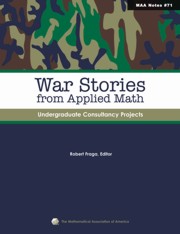Book contents
- Frontmatter
- Contents
- Introduction
- An Industrial Mathematics Program
- Source of Problems: Industrial Contacts
- Panel Discussion Following “Industrial Contacts”
- Course Integration
- The Consortium for Mathematics and Its Applications (COMAP)
- Program Management
- Project Deliverables I
- Project Deliverables II
- Using Projects from Industry to Teach Mathematics and Statistics to Liberal Arts Majors
- Mathematical Modeling in ICIC Projects
- Appendix: A Sample HMC Report
Panel Discussion Following “Industrial Contacts”
- Frontmatter
- Contents
- Introduction
- An Industrial Mathematics Program
- Source of Problems: Industrial Contacts
- Panel Discussion Following “Industrial Contacts”
- Course Integration
- The Consortium for Mathematics and Its Applications (COMAP)
- Program Management
- Project Deliverables I
- Project Deliverables II
- Using Projects from Industry to Teach Mathematics and Statistics to Liberal Arts Majors
- Mathematical Modeling in ICIC Projects
- Appendix: A Sample HMC Report
Summary
How are projects undertaken by students, as described in the preceding chapters, perceived by their clients? To gain some insight into their point of view, the editor invited several representatives from various industries to talk about their own perception of student projects. An edited version of their comments is given below.
Participants and their affiliations are as follows:
Mark Kopczynski [MK], Allen Bradley Company
Dirk Wilken [DW], Harley Davidson Company
Dan Guaglianone [DG], Abbott Laboratories
Martha Siegel [MS], Towson State University
George Corliss [GC], Marquette University
Robert Borrelli [RB], Harvey Mudd College
MK: One of the most important issues to consider is communications. That is probably what's going to get you into trouble over the long term. Patience is required in view of the activities in the follow-up because the project is unlikely to be an instant success. That needs to be stressed to the client.
What we learned at Allen Bradley was the importance of the team concept. This may relate to the perception that mathematicians are not game-oriented people. I'd recommend that you familiarize your students with the team concept: who the players are, what roles they play, and even to identify personalities on the team. That way you can account for why people react the way they do. We did that at Allen Bradley just to identify teams and what roles people play on them. We assume that the team leader should be doing certain things although the team leader may not understand everything that's going on.
From an industrial point of view, one of the key questions involves figuring out how industry and the academic world can complement each other's strengths.
- Type
- Chapter
- Information
- War Stories from Applied MathUndergraduate Consultancy Projects, pp. 39 - 46Publisher: Mathematical Association of AmericaPrint publication year: 2007



